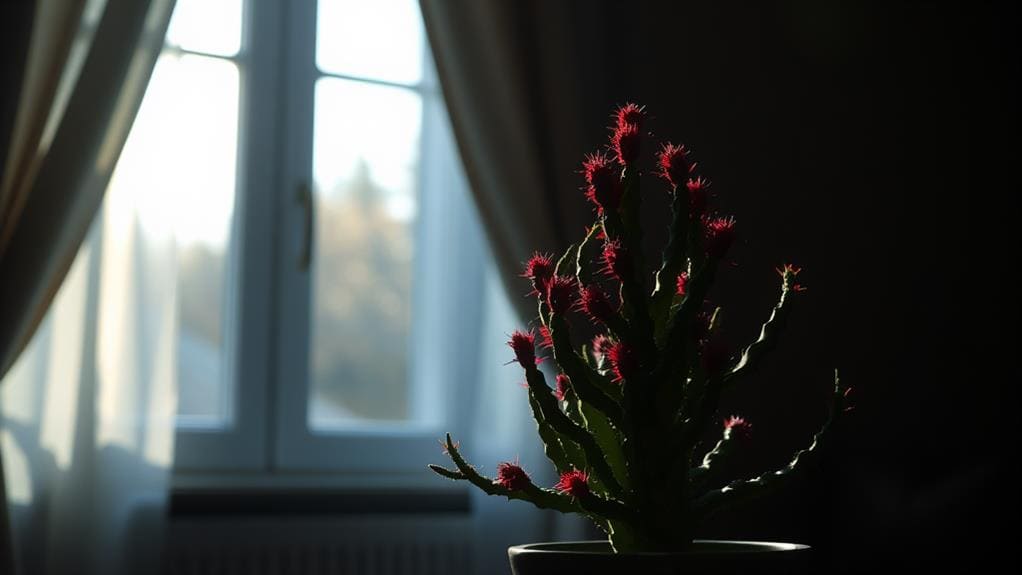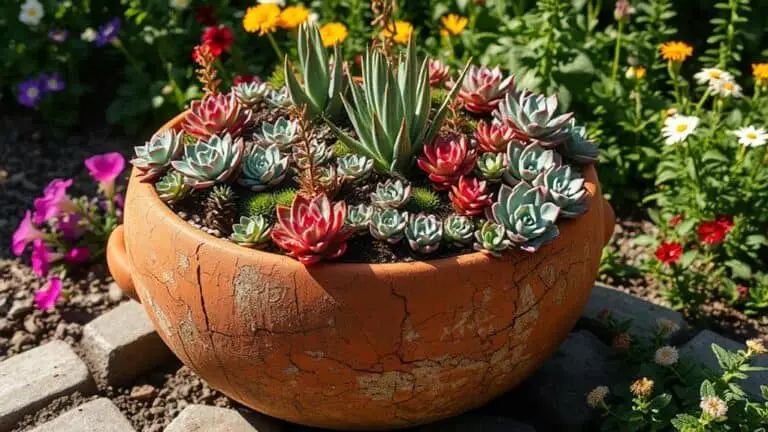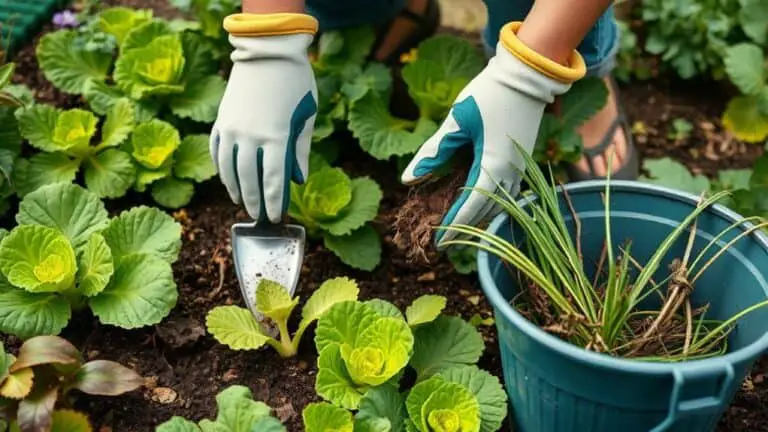Should I Keep My Christmas Cactus In The Dark
You might be wondering if keeping your Christmas cactus in the dark is really necessary for it to bloom beautifully. I found that providing 12 to 13 hours of uninterrupted darkness daily for about six to eight weeks can make a significant difference. This darkness mimics natural seasonal changes, helping the plant develop buds. But there are specific conditions and techniques to follow to get the best results. Curious about what those might be and how to avoid common pitfalls?
Understanding Christmas Cactus
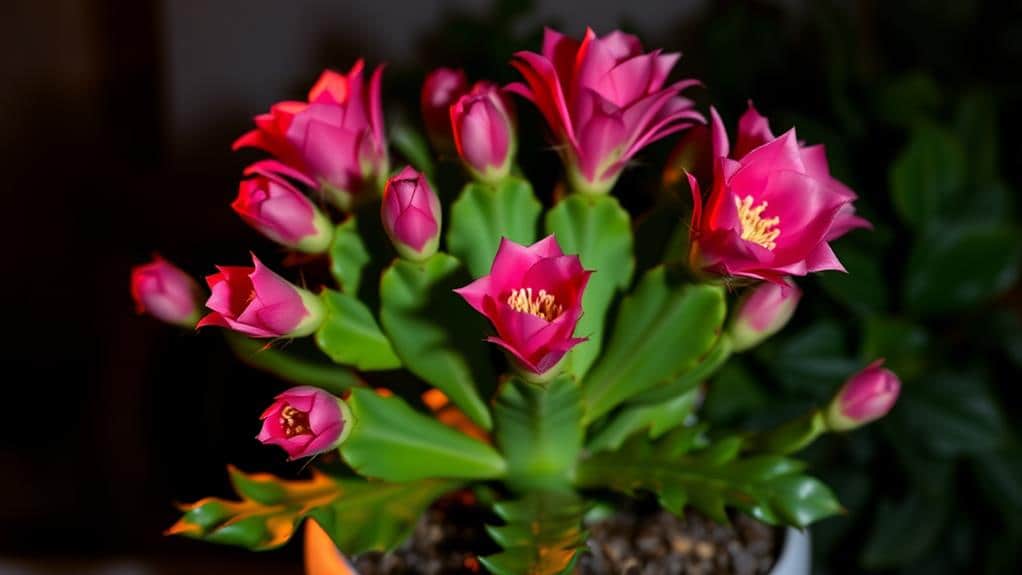
When it comes to understanding the Christmas cactus, it's vital to recognize its unique background and needs. Unlike traditional cacti, the Christmas cactus thrives in the tropical rainforests of southeastern Brazil.
It's an epiphyte, meaning it grows on trees and rocks. The plant's segmented, flat stems and colorful winter blooms set it apart.
To get those beautiful flowers, the Christmas cactus needs at least 12 hours of darkness each day. This darkness is essential for forming flower buds. Without this dark period, buds won't develop properly.
Light Preferences
When it comes to light preferences for your Christmas cactus, it's important to find just the right balance.
These plants thrive in bright, indirect sunlight, so placing them near a north-facing window is ideal.
However, be sure to avoid direct sunlight that can scorch the leaves, and consider adjusting their placement during winter to guarantee they get enough light.
Optimal Light Conditions
Understanding the ideal light conditions for your Christmas cactus is vital for its health and blooming potential.
Your cactus thrives best in bright, indirect light. Placing it near east or west-facing windows works wonders. Direct light can scorch the leaves, causing stress and affecting blooming.
During its growing season, it can handle lower light levels, but still needs enough light for healthy growth. For bud formation, providing at least 12 hours of darkness daily before blooming is vital.
Remember, as seasons change, light exposure will too. In winter, you might need to move your cactus to a brighter spot.
Proper light management guarantees your Christmas cactus stays vibrant and ready to bloom beautifully.
Avoid Direct Sunlight
Avoiding direct sunlight is essential for your Christmas cactus. These plants thrive in bright, indirect sunlight, similar to their natural habitat in tropical rainforests.
Direct sunlight can scorch their leaves, causing stress and reducing their flowering potential. Here's how you can guarantee your Christmas cactus gets the right light:
- Place near north-facing windows: These spots provide ample light without harsh sun exposure.
- Use sheer curtains: If a north-facing window isn't available, sheer curtains can filter the light effectively.
- Rotate the plant: Turn your Christmas cactus occasionally to guarantee even light distribution.
- Monitor for low light: While they can tolerate low light, they need enough indirect sunlight for healthy growth and blooming.
Following these tips helps keep your Christmas cactus happy and blooming!
Seasonal Light Adjustments
Have you ever wondered how to adjust the light for your Christmas cactus throughout the year?
It's essential to understand their seasonal light needs. During winter, natural light diminishes, so you should move your cactus to a brighter spot, like near a north-facing window, but avoid direct sunlight to prevent leaf scorch.
To encourage bud formation, make sure your cactus gets at least 12 hours of darkness every night. This darkness signals the plant to start forming buds.
Be careful with artificial lights, as interruptions can stop the blooming process.
By adjusting the light exposure based on the season, you'll help your Christmas cactus thrive and bloom beautifully.
Don't worry, you've got this!
Role of Darkness

In the journey to get your Christmas cactus to bloom beautifully, darkness plays an essential role. To form flower buds, your Christmas cactus needs at least 12 hours of darkness daily. This darkness mimics the natural seasonal changes and tells the plant it's time to prepare for flowering.
Here's what you need to know:
- Duration: Guarantee 6 weeks of uninterrupted darkness starting from mid-September.
- Consistency: Even brief interruptions can stop bud formation.
- Temperature: Combine darkness with cooler temperatures, ideally between 55°F and 65°F, for best results.
- Patience: Be patient, as this process takes dedication and time.
Promoting Bud Formation
Promoting bud formation in your Christmas cactus requires a blend of discipline and attentiveness. To encourage bud formation, you need to provide your cactus with at least 12 hours of darkness daily for about two months before you expect it to bloom.
I find moving the plant to a dark location or covering it with a dark cloth overnight works well. Be careful, though—interrupting this darkness, even for a couple of hours, can suppress bud formation and delay flowering.
Once buds appear, return the cactus to a bright, indirect light environment to support their growth. Consistently monitor temperature and humidity during the dark period, as these factors can further enhance bud formation and lead to successful blooming.
Flowering Timeline

To get your Christmas cactus to bloom on time, you'll need to follow a specific timeline for bud development.
Start by giving it at least 12 hours of darkness each day for about eight weeks before you want it to bloom.
Once the buds appear, move the cactus to a brighter spot to help the flowers grow and open beautifully.
Bud Development Period
Ensuring your Christmas cactus blooms beautifully requires careful attention to its bud development period. Here's what I've learned:
- Darkness: For bud formation, provide at least 12 hours of darkness daily for about two months before the bloom period.
- Consistent Schedule: Stick to this routine because even brief light exposure can delay the flowering process.
- Patience: Buds can take up to 12 weeks to develop, so be patient and consistent with the darkness treatment.
- Light Shift: Once you see buds, move the cactus to bright, indirect light to support healthy growth and flowering.
Optimal Blooming Conditions
Creating the perfect conditions for your Christmas cactus to bloom involves a bit of planning and attentiveness.
To kick off the flowering process, you need to place your cactus in darkness for 12-13 hours a day, about 8 weeks before you want it to bloom. This period of darkness is essential for bud formation. Even a brief interruption can prevent buds from forming, so consistency is key.
Once the buds start to form, which can take around 12 weeks, move the cactus back to a spot with bright, indirect light. This helps the buds develop fully and supports the blooming process.
Patience and careful planning will reward you with a beautifully blooming Christmas cactus. Keep at it, and you'll do great!
Seasonal Lighting Adjustments
When it comes to getting your Christmas cactus to bloom, understanding the seasonal lighting adjustments is crucial. The cactus needs at least 12 hours of continuous darkness each day for about two months before its flowering season, starting in mid-September.
Here's a simple guide to help:
- Darkness Period: Guarantee 12 hours of continuous darkness daily.
- Location: Move your cactus to a dark location or cover it with a cloth overnight.
- Buds Formation: Expect buds within 3 to 4 weeks of starting the darkness treatment.
- Bright Conditions: Once buds appear, return the cactus to brighter conditions, avoiding direct sunlight.
Seasonal Care Tips
As the holiday season approaches, it's vital to understand the seasonal care tips for your Christmas cactus to guarantee its stunning blooms. To initiate the flowering process, keep your cactus in complete darkness for 12 to 13 hours daily from late September. Darkness is important; any light interruptions can halt bud formation. Maintain a stable temperature between 55°F and 65°F during this period. Afterward, move your cactus to a bright spot with indirect light to encourage blooming.
| Task | Timeframe | Tips |
|---|---|---|
| Darkness Treatment | Late September to November | 12-13 hours of darkness |
| Temperature Care | During darkness period | 55°F to 65°F |
| Watering Adjustments | During darkness treatment | Only when top inch is dry |
| Light Exposure | After bud formation | Bright, indirect light |
| Bloom Period | Early November to January | Enjoy the beautiful blooms! |
Reduce watering during darkness to prevent root rot. Happy gardening!
Common Mistakes
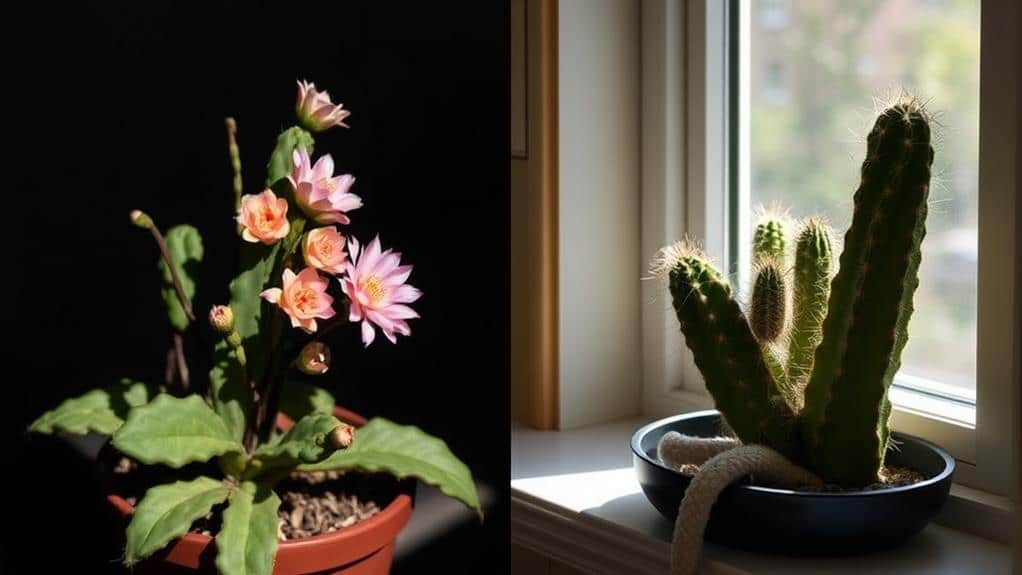
One of the most common mistakes gardeners make with their Christmas cactus isn't providing the necessary 12 hours of uninterrupted darkness each day. This dark period is essential for bud formation and vibrant flower colors.
Here are some key errors to avoid:
- Interrupting the dark period: Even a brief interruption can prevent buds from forming.
- Neglecting the dark period: Remember to move your cactus to a dark spot for 6-8 weeks before you expect it to bloom.
- Ignoring temperature needs: The ideal night temperature during the dark period is between 55°F and 65°F.
- Overwatering: Reduce watering during the dark period to help the cactus enter dormancy and promote bud formation.
Troubleshooting Issues
Troubleshooting issues with your Christmas cactus can feel challenging, but a few key adjustments can make all the difference.
If your cactus isn't blooming, it mightn't be getting enough darkness. It needs 12-13 hours of darkness daily for about eight weeks before the flowering season. Even brief interruptions in darkness can stop bud formation, leading to fewer flowers.
Try moving it to a darker spot or covering it with a cloth at night. Also, keep an eye on the temperature; it shouldn't go above 90°F, or the flowers might drop.
Once buds appear, move the cactus to a brighter location, but avoid direct sunlight to prevent scorching the leaves.
These small tweaks can help your cactus thrive.
Proper Watering Techniques
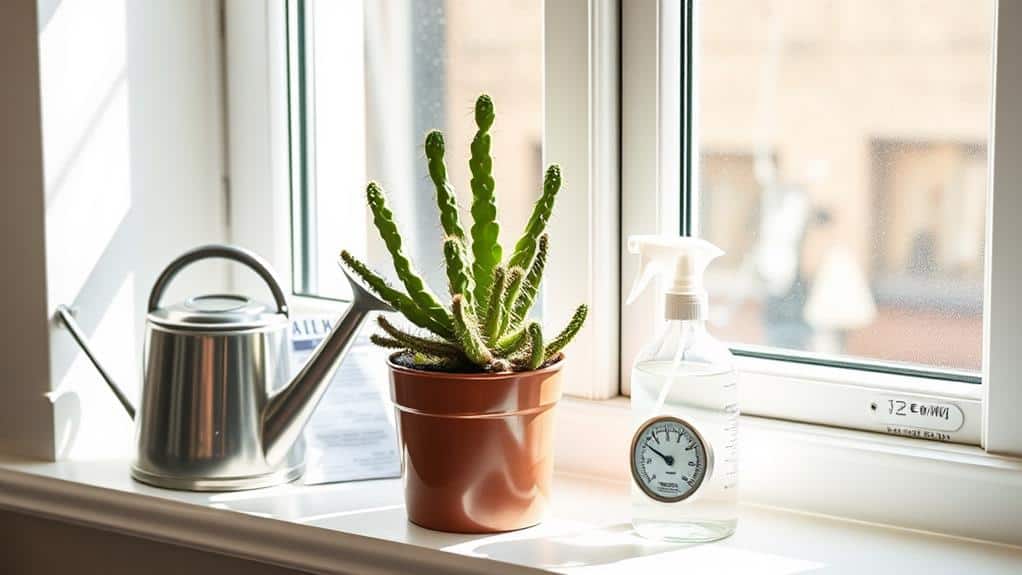
When it comes to watering your Christmas cactus, timing and technique are key to keeping it healthy.
Water only when the top inch of soil feels dry to avoid root rot, and adjust the frequency based on the season—more often in summer and less in winter.
Room temperature water works best, and don't forget to mist the plant to maintain the humidity it loves.
Ideal Watering Frequency
To keep your Christmas cactus thriving, it's crucial to get the watering frequency just right. During the growing season, you should water when the top inch of soil feels dry, usually every 1-2 weeks.
As the Christmas cactus can bloom with lower temperatures and long nights, adjust watering during winter dormancy.
Here's a simple guide:
- Check Soil Moisture: Feel the top inch of the soil. If it's dry, it's time to water.
- Proper Drainage: Make sure your pot has drainage holes to avoid root rot.
- Room Temperature Water: Use water at room temperature to prevent shocking the roots.
- Humidity: Mist your plant to maintain moisture and avoid overwatering.
Pay attention to signs of stress and adjust accordingly. Happy gardening!
Preventing Root Rot
Preventing root rot in your Christmas cactus hinges on mastering proper watering techniques. First, let the top inch of soil dry out completely before watering. Overwatering can lead to root rot, a common issue with these plants.
When you do water, use room temperature water to avoid shocking the roots. Make sure your pot has drainage holes so excess water can escape. This step is essential to prevent water from sitting at the bottom and causing root rot.
During the winter dormancy period, reduce your watering frequency. Only water when the top inch of soil feels dry.
Watch for signs of overwatering, like yellowing or squishy leaves. These are indicators that the roots may be rotting due to excessive moisture.
Fertilization Practices
Caring for your Christmas cactus includes paying attention to its fertilization needs to confirm it thrives and blooms beautifully. Here are some key fertilization practices to follow:
- Use a balanced, water-soluble fertilizer: This promotes healthy growth and blooming. Make sure the soil drains well to prevent root issues.
- Fertilize every 4-6 weeks: Do this during the growing season, from spring until blooming ends in winter.
- Increase phosphorus levels: Before the expected bloom, boost phosphorus to encourage bud formation.
- Reduce or stop fertilization after flowering: The plant enters a dormant phase then and doesn't need extra nutrients.
Additionally, conduct soil testing to confirm a pH of 5.5 to 6.0 for ideal nutrient uptake, enhancing overall plant health.
Frequently Asked Questions
Do I Need to Put My Christmas Cactus in the Dark?
Yes, you should reduce light exposure to initiate the bloom cycle. Keeping my Christmas cactus in the dark for 12 hours daily triggers plant dormancy, essential for flowering. Interruptions can negatively affect its bloom cycle.
Where Is the Best Place to Put a Christmas Cactus?
I'd place my Christmas cactus near a north-facing window for ideal light exposure. It thrives in bright, indirect light, stable temperature preferences, and moderate humidity levels. Avoid direct sun and sudden environmental changes to guarantee blooming.
When Should I Bring My Christmas Cactus Inside?
I'd bring my Christmas cactus inside around mid-September. At that time, nighttime temperatures drop below 60°F. This helps it adapt to indoor temperature and light exposure, ensuring it handles seasonal changes without losing buds.
How Often Should a Christmas Cactus Be Watered?
I water my Christmas cactus every 1-2 weeks during its growing season, adjusting the watering frequency based on soil moisture and humidity levels. In winter, I reduce watering, letting the soil dry out more between waterings.
Conclusion
To sum up, keeping your Christmas cactus in the dark for 12 to 13 hours daily is key to getting those beautiful blooms. Remember to maintain cool temperatures and be patient during the 6 to 8 weeks of darkness. Once buds appear, move your cactus to bright, indirect light for healthy growth. Don't worry if it sounds tricky; just follow these steps and you'll be rewarded with a stunning, flowering cactus. Happy gardening! You've got this!

